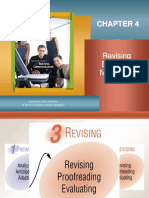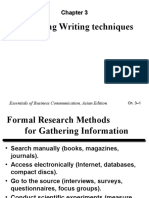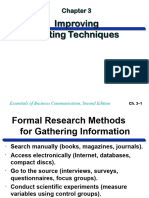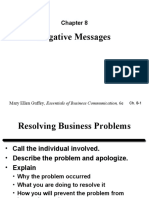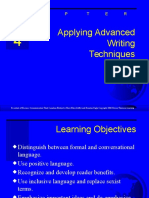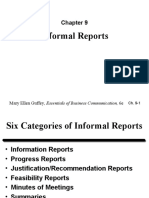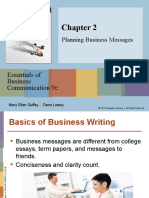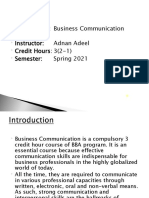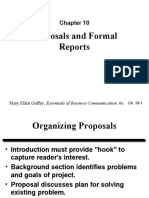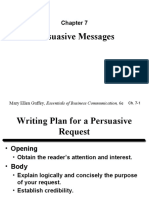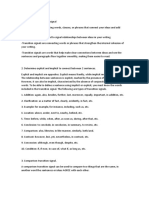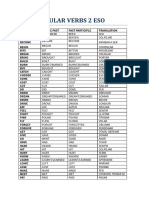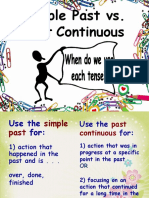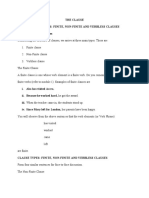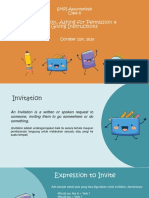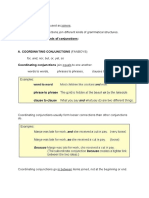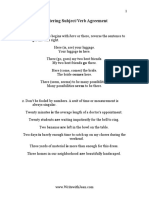Improving Writing Techniques: Mary Ellen Guffey, Essentials of Business Communication, 6e
Uploaded by
Noor shahImproving Writing Techniques: Mary Ellen Guffey, Essentials of Business Communication, 6e
Uploaded by
Noor shahChapter 3
Improving Writing techniques
Mary Ellen Guffey, Essentials of Business Communication, 6e Ch. 3-1
Formal Research Methods for
Gathering Information
• Search manually (books, magazines,
journals).
• Access electronically (Internet, databases,
compact discs).
• Go to the source (interviews, surveys,
questionnaires, focus groups).
• Conduct scientific experiments (measure
variables using control groups).
Mary Ellen Guffey, Essentials of Business Communication, 6e Ch. 3-2
Informal Research Methods for
Gathering Information
• Look in organization files.
• Talk with your boss.
• Interview the target audience.
• Conduct an informal survey.
• Brainstorm for ideas.
Mary Ellen Guffey, Essentials of Business Communication, 6e Ch. 3-3
Organize Information With an
Outline
Title
I. First major component
A. First subpoint
1. Detail, illustration, evidence
2. Detail, illustration, evidence
B. Second subpoint
1. Detail, illustration, evidence
2. Detail, illustration, evidence
Mary Ellen Guffey, Essentials of Business Communication, 6e Ch. 3-4
Organize Information With an
Outline
II. Second major component
A. First subpoint
1. Detail, illustration, evidence
2. Detail, illustration, evidence
Mary Ellen Guffey, Essentials of Business Communication, 6e Ch. 3-5
Organize Information With an
Outline
Tips:
• Define main topic in title.
• Divide the topic into three to five main points.
• Break the components into subpoints.
• Strive to make each component exclusive (no
overlapping).
• Don’t put a single item under a major component.
• Use details, illustrations, and evidence to support
subpoints.
Mary Ellen Guffey, Essentials of Business Communication, 6e Ch. 3-6
Organizing Business Messages
Direct Strategy Indirect Strategy
Main idea comes first Explanation precedes
followed by details and main idea
explanations
Mary Ellen Guffey, Essentials of Business Communication, 6e Ch. 3-7
Organizing Business Messages
Direct Strategy Indirect Strategy
Advantages: Advantages:
• Saves reader’s time • Respects feelings of
audience
• Sets a proper frame of
• Encourages a fair
mind
hearing
• Prevents frustration
• Minimizes a negative
• Appears businesslike reaction
Mary Ellen Guffey, Essentials of Business Communication, 6e Ch. 3-8
Organizing Business Messages
Direct Strategy Indirect Strategy
Useful when: Useful when:
• Receiver is receptive • Receiver may be upset
• Receiver requires no • Receiver may be hostile
education about topic • Receiver must be
• Message is routine persuaded or educated
• Message is sensitive
Mary Ellen Guffey, Essentials of Business Communication, 6e Ch. 3-9
Effective Sentences
Complete sentences have subjects and
verbs and make sense (are capable of
standing alone).
Example:
Subject Verb
Employees send many e-mail messages.
Mary Ellen Guffey, Essentials of Business Communication, 6e Ch. 3-10
Effective Sentences
Clauses also have subjects and verbs.
Independent clauses can stand alone;
dependent clauses rely on independent
clauses for their meaning.
Example:
Dependent Clause Independent Clause
When you speak, you reveal yourself.
Mary Ellen Guffey, Essentials of Business Communication, 6e Ch. 3-11
Effective Sentences
Phrases are groups of related words
without subjects and verbs.
Example:
Phrase Phrase
In the afternoon, I work at the mall.
Mary Ellen Guffey, Essentials of Business Communication, 6e Ch. 3-12
Effective Sentences
Avoid sentence fragments.
Fragment
Even though the pay was low. Many candidates
applied.
Revision:
Even though the pay was low, many candidates
applied.
Mary Ellen Guffey, Essentials of Business Communication, 6e Ch. 3-13
Effective Sentences
Avoid run-on (fused) sentences.
Fused Sentences
Two candidates applied only one was hired.
Revisions:
Two candidates applied. Only one was hired.
Two candidates applied; only one was hired.
Two candidates applied, but only one was hired.
Mary Ellen Guffey, Essentials of Business Communication, 6e Ch. 3-14
Effective Sentences
Avoid comma-splice sentences.
Comma Splice
Many were qualified, Jeff was hired.
Revisions:
Many were qualified. Jeff was hired.
Many were qualified; Jeff was hired.
Many were qualified; however, Jeff was hired.
Many were qualified, but Jeff was hired.
Mary Ellen Guffey, Essentials of Business Communication, 6e Ch. 3-15
Try Your Skill
Revise the following to avoid fragments,
run-on sentences, and comma-splices.
• You can create a Web-based job portfolio it
will impress potential employers.
You can create a Web-based job portfolio; it
will impress potential employers.
Mary Ellen Guffey, Essentials of Business Communication, 6e Ch. 3-16
Try Your Skill
Revise the following to avoid fragments,
run-on sentences, and comma-splices.
• Send a scannable résumé. When you apply
for a job.
Send a scannable résumé when you apply for
a job.
Mary Ellen Guffey, Essentials of Business Communication, 6e Ch. 3-17
Try Your Skill
Revise the following to avoid fragments,
run-on sentences, and comma-splices.
• Although technical skills are important.
Communication skills are also in great
demand.
Although technical skills are important,
communication skills are also in great demand.
Mary Ellen Guffey, Essentials of Business Communication, 6e Ch. 3-18
Try Your Skill
Revise the following to avoid fragments,
run-on sentences, and comma-splices.
• College used to be for young people, however
many older students now seek degrees.
College used to be for young people; however,
many older students now seek degrees.
Mary Ellen Guffey, Essentials of Business Communication, 6e Ch. 3-19
Emphasis Through Mechanics
Underlining:
Which of these methods do you prefer?
Mary Ellen Guffey, Essentials of Business Communication, 6e Ch. 3-20
Emphasis Through Mechanics
Italics and Boldface:
The use of boldface and italics captures the
reader’s attention.
Mary Ellen Guffey, Essentials of Business Communication, 6e Ch. 3-21
Emphasis Through Mechanics
All Caps:
Notice how EXPENSE-FREE stands out.
Mary Ellen Guffey, Essentials of Business Communication, 6e Ch. 3-22
Emphasis Through Mechanics
Dashes:
Other methods–including dashes–may be
used.
Mary Ellen Guffey, Essentials of Business Communication, 6e Ch. 3-23
Emphasis Through Mechanics
Tabulation:
Listing items vertically emphasizes them:
1. First item
2. Second item
3. Third item
Mary Ellen Guffey, Essentials of Business Communication, 6e Ch. 3-24
Emphasis Through Mechanics
• Other means of achieving mechanical
emphasis include the following: use of
white space, color, lines, boxes, columns,
titles, headings, and subheadings.
• Which of the above techniques are
appropriate in business letters? Memos?
E-mail messages? Reports?
Mary Ellen Guffey, Essentials of Business Communication, 6e Ch. 3-25
Emphasis and Deemphasis
Through Style
• To emphasize an idea:
• Use a vivid expression, such as in “bug-free software”
rather than “dependable software.”
• Label the idea with expressions such as more
importantly, the principal reason, or the best
alternative.
• Put the important idea first or last in the sentence.
• Put the important idea in a simple sentence or in an
independent clause.
Mary Ellen Guffey, Essentials of Business Communication, 6e Ch. 3-26
Emphasis and Deemphasis
Through Style
• To deemphasize an idea:
• Use general, rather than specific, words (some
customers complained, rather than 125 customers
complained).
• Place the idea in a dependent clause connected to an
independent clause containing a positive idea.
Example:
Although items cannot be returned for cash, you will receive
store credit for any returned purchases.
Mary Ellen Guffey, Essentials of Business Communication, 6e Ch. 3-27
Active- and Passive-Voice Verbs
Active-voice verbs show the subject performing
the action.
Examples:
Most major employers require drug testing.
(Active voice; the subject is acting)
Dr. Smith recommended Tina for the job.
(Active voice; the subject is acting)
Mary Ellen Guffey, Essentials of Business Communication, 6e Ch. 3-28
Active- and Passive-Voice Verbs
In passive-voice sentences, the subject is being
acted upon. Passive-voice verbs require helper
verbs.
Examples:
Drug testing is required by most major employers.
(Passive voice; the subject is being acted upon)
Tina was recommended for the job by Dr. Smith.
(Passive voice; the subject is being acted upon)
Mary Ellen Guffey, Essentials of Business Communication, 6e Ch. 3-29
Active- and Passive-Voice Verbs
• Use the active voice for most business writing.
• Use the passive voice to emphasize an action
or the recipient of the action–rather than the
actor (Specialists were hired; Laura was
honored).
• Use the passive voice to break bad news
(Although your lease cannot be renewed, we
can offer . . . ).
Mary Ellen Guffey, Essentials of Business Communication, 6e Ch. 3-30
Try Your Skill
Convert the following sentence to active
voice. You may have to add a subject.
• Our membership meeting was postponed by
the president.
The president postponed our membership
meeting.
Mary Ellen Guffey, Essentials of Business Communication, 6e Ch. 3-31
Try Your Skill
Convert the following sentence to active
voice. You may have to add a subject.
• The résumés of job candidates are sorted
quickly by the software program Resumix.
The software program Resumix sorts
résumés of job candidates quickly.
Mary Ellen Guffey, Essentials of Business Communication, 6e Ch. 3-32
Try Your Skill
Convert the following sentence to active
voice. You may have to add a subject.
• Computer paper was ordered yesterday.
Rachel ordered computer paper yesterday.
Mary Ellen Guffey, Essentials of Business Communication, 6e Ch. 3-33
Try Your Skill
Convert the following sentence to passive
voice.
• We must delay shipment of your
merchandise because of heavy demand.
Your merchandise shipment must be delayed
because of heavy demand.
Mary Ellen Guffey, Essentials of Business Communication, 6e Ch. 3-34
Try Your Skill
Convert the following sentence to passive
voice.
• The technician could not install the computer
program.
The computer program could not be installed.
Mary Ellen Guffey, Essentials of Business Communication, 6e Ch. 3-35
Developing Parallelism
Parallel expression results from balanced
construction. Match nouns with nouns,
verbs with verbs, phrases with phrases,
and clauses with clauses.
Mary Ellen Guffey, Essentials of Business Communication, 6e Ch. 3-36
Developing Parallelism
Poor: The process of writing involves
organizing, composing, and
revision.
Parallel: The process of writing involves
organizing, composing, and
revising. (Matching endings of
verbals)
Mary Ellen Guffey, Essentials of Business Communication, 6e Ch. 3-37
Developing Parallelism
Poor: We are very concerned with the
quality of raw materials, where they are
located, and how much it costs to transport
them.
Parallel: We are very concerned with the
quality, location, and transpor- tation costs
of raw materials. (Matching nouns)
Mary Ellen Guffey, Essentials of Business Communication, 6e Ch. 3-38
Developing Parallelism
Poor: Serena takes the telephone
orders, Matt locates the items in
the warehouse, and the items are
sent by Yolanda.
Parallel: Serena takes the telephone
orders, Matt locates the items in
the warehouse, and Yolanda
sends the items. (Matching voices
of verbs)
Mary Ellen Guffey, Essentials of Business Communication, 6e Ch. 3-39
Try Your Skill
How could parallelism be improved in the
following sentence?
• Our knowledge management system focuses
on the collecting, storage, and sharing of
best practices.
Our knowledge management system focuses
on the collecting, storing, and sharing of best
practices.
Mary Ellen Guffey, Essentials of Business Communication, 6e Ch. 3-40
Try Your Skill
How could parallelism be improved in the
following sentence?
• We are pleased to recommend Elizabeth
because she has sincerity, she is reliable,
and she works with diligence.
We are pleased to recommend Elizabeth
because she is sincere, reliable, and diligent.
Mary Ellen Guffey, Essentials of Business Communication, 6e Ch. 3-41
Dangling and Misplaced Modifiers
For clarity, modifiers must be close to the
words they describe or limit. Be
particularly careful to place a logical
subject immediately after an introductory
verbal phrase.
Mary Ellen Guffey, Essentials of Business Communication, 6e Ch. 3-42
Dangling and Misplaced Modifiers
Poor: After considering the problem
carefully, new procedures were
suggested by management.
Revised: After considering the problem
carefully, management suggested
new procedures.
Mary Ellen Guffey, Essentials of Business Communication, 6e Ch. 3-43
Dangling and Misplaced Modifiers
Poor: Any student has full online
privileges who is enrolled in the
college.
Revised: Any student who is enrolled in the
college has full online privileges.
Mary Ellen Guffey, Essentials of Business Communication, 6e Ch. 3-44
Dangling and Misplaced Modifiers
Poor: It’s hard to understand why
employees would not go to our
technical support staff with software
problems.
Revised: It’s hard to understand why
employees with software problems would
not go to our technical support staff.
Mary Ellen Guffey, Essentials of Business Communication, 6e Ch. 3-45
Dangling and Misplaced Modifiers
Poor: Using a search engine, the Web
site was finally located.
Revised: Using a search engine, we finally
located the Web site.
Mary Ellen Guffey, Essentials of Business Communication, 6e Ch. 3-46
Try Your Skill
Revise the following sentence to correct
any misplaced modifiers. Retain the
introductory phrase.
• To be hired, two years of experience is
required.
To be hired, one must have two years of
experience.
Mary Ellen Guffey, Essentials of Business Communication, 6e Ch. 3-47
Try Your Skill
Revise the following sentence to correct
any misplaced modifiers. Retain the
introductory phrase.
• Dipped in butter, you can really enjoy a fine
lobster.
Dipped in butter, a fine lobster can truly be
enjoyed.
Mary Ellen Guffey, Essentials of Business Communication, 6e Ch. 3-48
Try Your Skill
Revise the following sentence to correct
any misplaced modifiers.
• She died in the house in which she was born
at the age of 88.
At the age of 88, she died in the house in
which she was born.
Mary Ellen Guffey, Essentials of Business Communication, 6e Ch. 3-49
Try Your Skill
Revise the following sentence to correct
any misplaced modifiers.
• To receive an employment form, fill out this
application. (Tricky!)
The sentence is correct as it stands. “You” is the understood
subject of a command.
Mary Ellen Guffey, Essentials of Business Communication, 6e Ch. 3-50
Three Ways to Achieve Paragraph
Coherence
To help guide your reader or listener from
one thought to another, develop
coherence by using one of these devices:
1. Repeat a key idea or key word(s).
Next month we plan to launch a promotion
for our new Web site. The promotion will
involve newspaper and TV campaigns.
Mary Ellen Guffey, Essentials of Business Communication, 6e Ch. 3-51
Three Ways to Achieve Paragraph
Coherence
2. Use a pronoun.
Considerable interest is now being shown in
our extended certificates of deposit. They
are more profitable when left on deposit for
long periods of time.
Mary Ellen Guffey, Essentials of Business Communication, 6e Ch. 3-52
Three Ways to Achieve Paragraph
Coherence
3. Use an appropriate transitional
expression.
Time Association Contrast
before, after although
first, second but
meanwhile however
next instead
until nevertheless
when, whenever on the other hand
Mary Ellen Guffey, Essentials of Business Communication, 6e Ch. 3-53
Three Ways to Achieve Paragraph
Coherence
3. Use an appropriate transitional
expression.
Cause–Effect Additional Idea
consequently furthermore
for this reason in addition
hence likewise
therefore moreover
similarly
Mary Ellen Guffey, Essentials of Business Communication, 6e Ch. 3-54
Three Ways to Achieve Paragraph
Coherence
3. Use an appropriate transitional
expression.
Illustration
in this way
for example
Mary Ellen Guffey, Essentials of Business Communication, 6e Ch. 3-55
Paragraph Length
Paragraphs with eight or fewer printed lines
look inviting and readable.
Mary Ellen Guffey, Essentials of Business Communication, 6e Ch. 3-56
Composing the First Draft
• Complete all necessary research.
• Find a quiet place to concentrate and work.
• Prohibit calls, visitors, and interruptions.
• Organize information using an outline.
• Decide whether to sprint write (get your thoughts
down quickly and revise later) or revise as you go.
• Imagine you are talking to a reader or listener.
Mary Ellen Guffey, Essentials of Business Communication, 6e Ch. 3-57
End
Mary Ellen Guffey, Essentials of Business Communication, 6e Ch. 3-58
You might also like
- Olga Kagan, Frank Miller - V Puti - Russian Grammar in Context 1st Edition-Prentice Hall (1995)100% (3)Olga Kagan, Frank Miller - V Puti - Russian Grammar in Context 1st Edition-Prentice Hall (1995)412 pages
- Revising and Proofreading Business Messages: Mary Ellen Guffey, Essentials of Business Communication, 6eNo ratings yetRevising and Proofreading Business Messages: Mary Ellen Guffey, Essentials of Business Communication, 6e33 pages
- Composing Business Messages: Essentials of Business Communication 9eNo ratings yetComposing Business Messages: Essentials of Business Communication 9e39 pages
- Writing For Business Audiences: Mary Ellen Guffey, Essentials of Business Communication, 6eNo ratings yetWriting For Business Audiences: Mary Ellen Guffey, Essentials of Business Communication, 6e26 pages
- Revising Business Messages: Instructor Only VersionNo ratings yetRevising Business Messages: Instructor Only Version43 pages
- Essentials of Business Communication, Second Edition: Ch. 3-1 Ch. 3-1No ratings yetEssentials of Business Communication, Second Edition: Ch. 3-1 Ch. 3-159 pages
- Improving Writing Techniques: Essentials of Business Communication, Asian EditionNo ratings yetImproving Writing Techniques: Essentials of Business Communication, Asian Edition58 pages
- Negative Messages: Mary Ellen Guffey, Essentials of Business Communication, 6eNo ratings yetNegative Messages: Mary Ellen Guffey, Essentials of Business Communication, 6e37 pages
- Informal Reports: Mary Ellen Guffey, Essentials of Business Communication, 6eNo ratings yetInformal Reports: Mary Ellen Guffey, Essentials of Business Communication, 6e26 pages
- Module - 5 (Iii) Revising Business MessagesNo ratings yetModule - 5 (Iii) Revising Business Messages44 pages
- Facing Today's Communication Challenges: Mary Ellen Guffey, Essentials of Business Communication, 6eNo ratings yetFacing Today's Communication Challenges: Mary Ellen Guffey, Essentials of Business Communication, 6e34 pages
- Writing Process Phase 3: Revise, Proofread, EvaluateNo ratings yetWriting Process Phase 3: Revise, Proofread, Evaluate37 pages
- Informal Reports: Mary Ellen Guffey, Essentials of Business Communication, 6eNo ratings yetInformal Reports: Mary Ellen Guffey, Essentials of Business Communication, 6e26 pages
- Blue and Yellow Playful Doodle Digital Brainstorm Presentation - 20240210 - 181611 - 0000No ratings yetBlue and Yellow Playful Doodle Digital Brainstorm Presentation - 20240210 - 181611 - 000030 pages
- Characteristics of Effective Business MessagesNo ratings yetCharacteristics of Effective Business Messages4 pages
- Revising Business Messages: Essentials of Business Communication 9eNo ratings yetRevising Business Messages: Essentials of Business Communication 9e25 pages
- Unit 2: The Writing Process in The Digital EraNo ratings yetUnit 2: The Writing Process in The Digital Era23 pages
- Written Comm - Planning and writing Business Messages.docNo ratings yetWritten Comm - Planning and writing Business Messages.doc11 pages
- Essentials of Business Communication 9eNo ratings yetEssentials of Business Communication 9e36 pages
- Persuasive and Analytical Writing For Business Communication100% (2)Persuasive and Analytical Writing For Business Communication56 pages
- Unit 5 Written Business Communication Part1No ratings yetUnit 5 Written Business Communication Part137 pages
- Chapter Five- Principles of CommunicationNo ratings yetChapter Five- Principles of Communication8 pages
- Lecture 1 - Foundation of Business CommunicationNo ratings yetLecture 1 - Foundation of Business Communication45 pages
- rishabh business communication assignmentNo ratings yetrishabh business communication assignment9 pages
- Career Success Begins With Communication Skills: Instructor Only VersionNo ratings yetCareer Success Begins With Communication Skills: Instructor Only Version43 pages
- Business Communication: Writing For A Positive EffectNo ratings yetBusiness Communication: Writing For A Positive Effect5 pages
- Complete Download of Test Bank for Business Communication Process & Product 3rd Edition Guffey Download Full Chapters in PDF DOCX100% (14)Complete Download of Test Bank for Business Communication Process & Product 3rd Edition Guffey Download Full Chapters in PDF DOCX18 pages
- Business Communication: Meaning of Communication: Communication Is A Process Used To PromoteNo ratings yetBusiness Communication: Meaning of Communication: Communication Is A Process Used To Promote12 pages
- Session 2 Principles of Effective CommunicationNo ratings yetSession 2 Principles of Effective Communication22 pages
- Ch01 Guffey Updated SPRING 2024 MKHn (1)No ratings yetCh01 Guffey Updated SPRING 2024 MKHn (1)40 pages
- So You Want to Start a Business: Eight Steps to Startup SuccessFrom EverandSo You Want to Start a Business: Eight Steps to Startup SuccessNo ratings yet
- Master IELTS Reading (General): Tips, Readings, and Practice QuestionsFrom EverandMaster IELTS Reading (General): Tips, Readings, and Practice QuestionsNo ratings yet
- 15 Powerful Examples of Neuromarketing in ActionNo ratings yet15 Powerful Examples of Neuromarketing in Action19 pages
- Assignment of Marketing: Name: Waseem Abbas Registration No: Sp19-BBA-109No ratings yetAssignment of Marketing: Name: Waseem Abbas Registration No: Sp19-BBA-1097 pages
- Proposals and Formal Reports: Mary Ellen Guffey, Essentials of Business Communication, 6eNo ratings yetProposals and Formal Reports: Mary Ellen Guffey, Essentials of Business Communication, 6e21 pages
- Persuasive Messages: Mary Ellen Guffey, Essentials of Business Communication, 6eNo ratings yetPersuasive Messages: Mary Ellen Guffey, Essentials of Business Communication, 6e42 pages
- Adjective Clauses: Siti Ainun, ST., Spsi., MSCNo ratings yetAdjective Clauses: Siti Ainun, ST., Spsi., MSC24 pages
- Simplepastvscontinuous 131210151932 Phpapp01No ratings yetSimplepastvscontinuous 131210151932 Phpapp0115 pages
- Vendor Management Training: Introduction About Vendor ManagemenNo ratings yetVendor Management Training: Introduction About Vendor Managemen11 pages
- Invitation, Asking For Permission & Giving Instructions: SMPI Assuryaniyah Class 8No ratings yetInvitation, Asking For Permission & Giving Instructions: SMPI Assuryaniyah Class 88 pages
- Conjunctions: A. Coordinating Conjunctions (Fanboys)No ratings yetConjunctions: A. Coordinating Conjunctions (Fanboys)7 pages
- Wallwork-Materiale Didattico 1-Top Grammar Mistakes PDFNo ratings yetWallwork-Materiale Didattico 1-Top Grammar Mistakes PDF28 pages
- Reported Speech: I Don't Have She Didn't Have I Am Tired He WasNo ratings yetReported Speech: I Don't Have She Didn't Have I Am Tired He Was11 pages
- COMPONENTIAL ANALYSIS of MEANING - An Introduction To Semantic Structures100% (1)COMPONENTIAL ANALYSIS of MEANING - An Introduction To Semantic Structures272 pages






